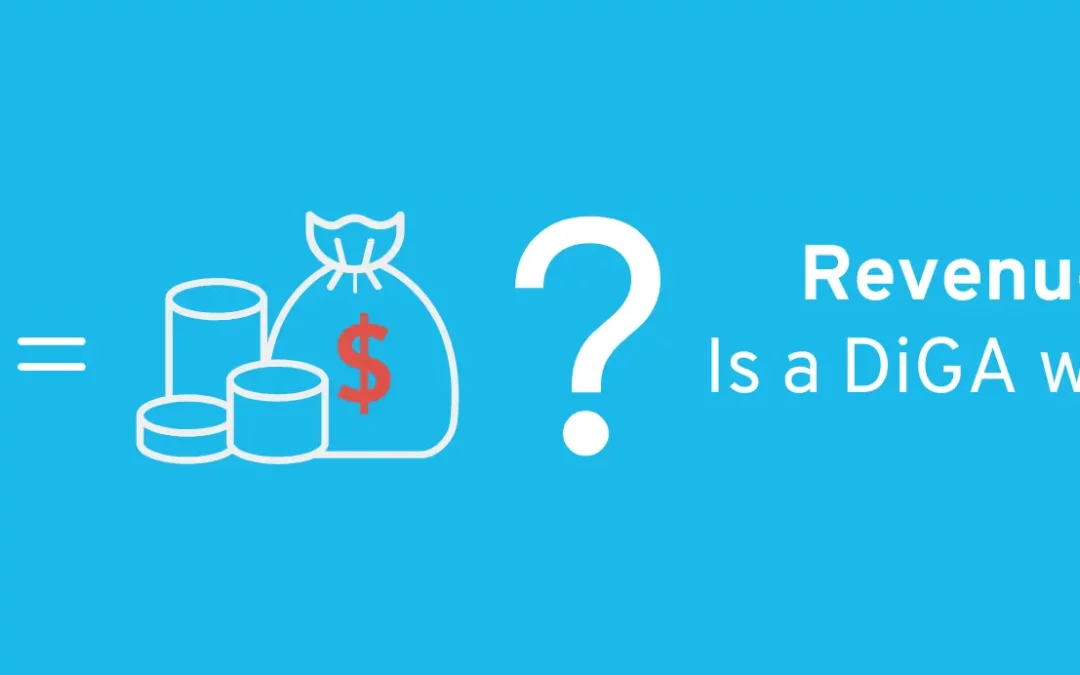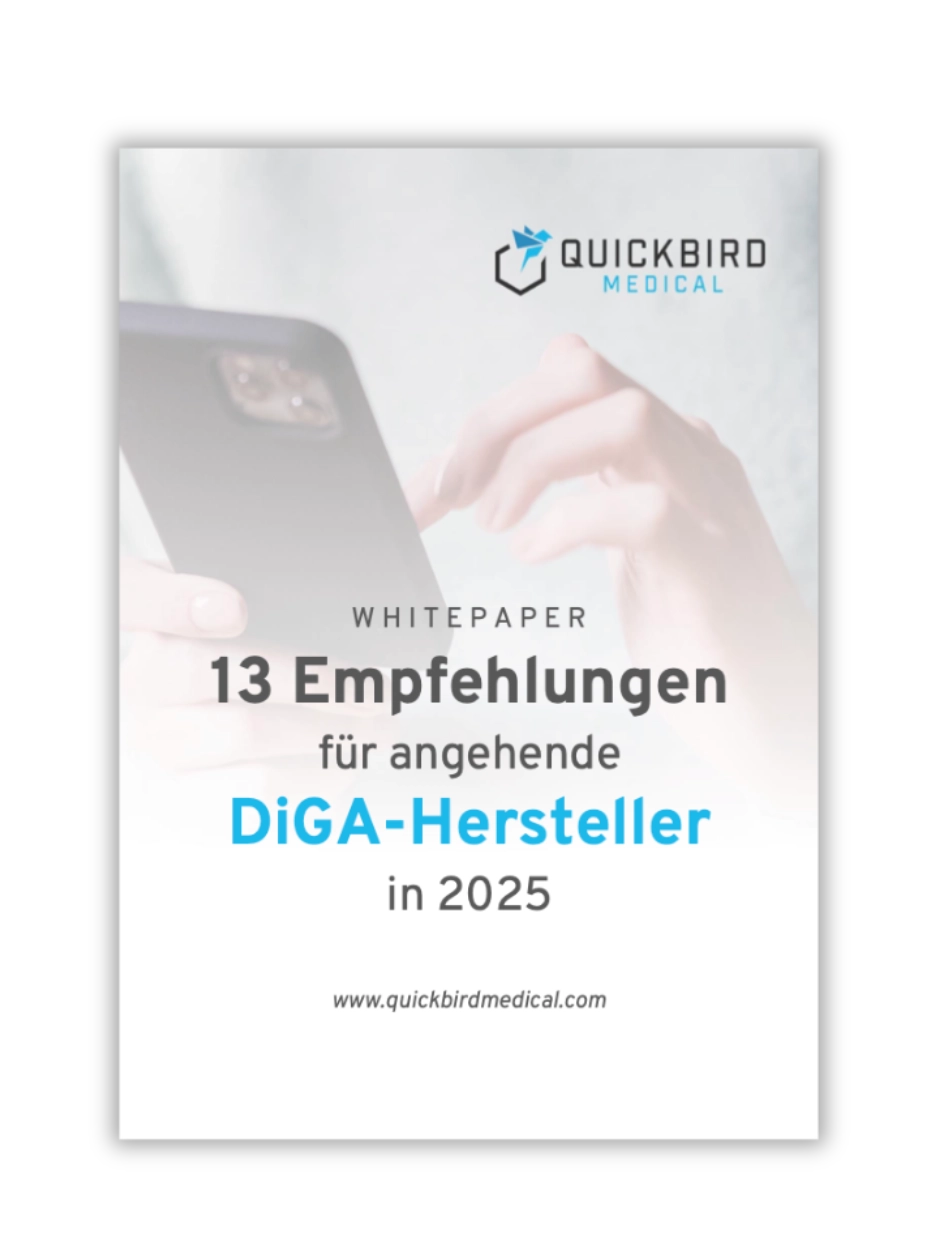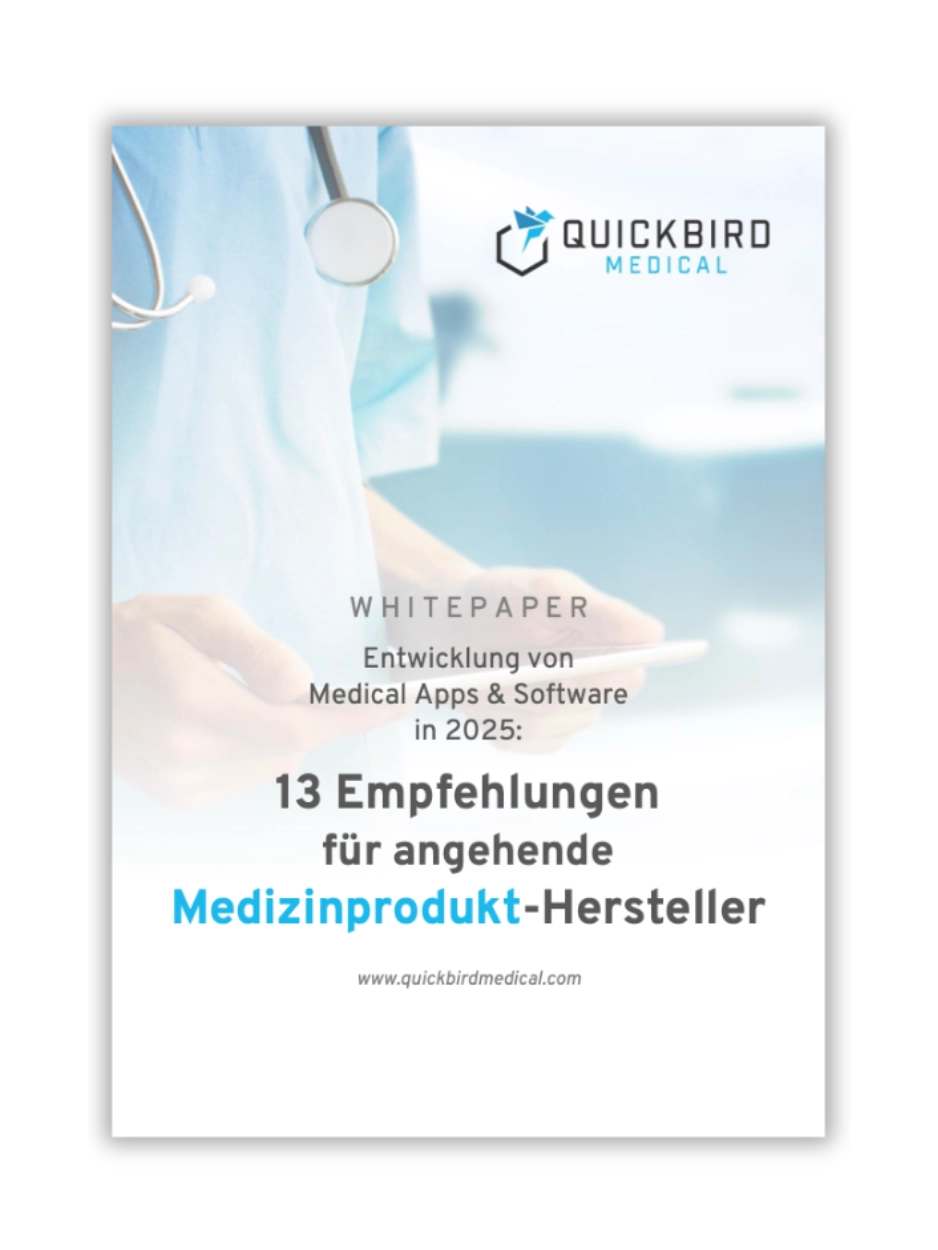As with any business idea, the financial potential of a DiGA project should be calculated at the outset.
A central question arises: Is the development of your DiGA idea worthwhile for you?
Potential investors for your DiGA project are also asking themselves this question. You should therefore be able to present a calculation with reliable figures.
The following key figures are particularly relevant here:
- Profit
- Sales (sales potential & market potential or TAM, SAM, SOM)
- Costs (development, study, marketing, etc.)
This article provides you with detailed instructions on how to calculate the potential of your DiGA for your targeted disease indication. You will also find a large number of sample calculations to make the topic as tangible as possible for you.
Content of this article
- 1. Profit & Return on Investment (ROI) of a DiGA
- 2. Costs for the development and marketing of a DiGA
- 3. Download: Excel planner for forecasting the turnover and costs of your DiGA
- 4. Conclusion
1. Profit & Return on Investment (ROI) of a DiGA
We start with the premise that your DiGA project has the goal of being profitable. To decide whether your DiGA case can be profitable, you should estimate the future profit or return on investment (ROI).
Even the calculation of a DiGA’s profit does not escape the basic principles of business management and follows a simple formula:
Profit = turnover – costs
The return on investment (ROI) is calculated as follows:
ROI = profit/costs
Now the question naturally arises: How concretely can “turnover” and “costs” be forecast? We address this question in detail in the following sections.
1.1 Turnover & market potential
Revenue is generated as soon as patients use the DiGA by redeeming an activation code. With each redemption, you as the manufacturer receive money from the health insurance companies in the amount of the price of your DiGA.
Patients receive the activation code from their health insurance company. This is done in two ways:
- Prescription by a doctor: The doctor prescribes the DiGA to the patient on the basis of a diagnosis
- Direct route to the health insurance company: The patient applies for an activation code from the health insurance company on the basis of a diagnosis that has already been made
Important: You will only receive money if the patient successfully receives an activation code at the end and also redeems it in your DiGA.
The formula for the turnover of a DiGA is therefore:
Turnover = DiGA price * activation code redemptions
For the sake of simplicity, we will not discuss other possible sources of revenue for DiGA (B2B cooperations, self-pay models, etc.) in this article.
Let’s start with the DiGA price: how can you predict what the DiGA price will be for your indication area?
1.2 Price or remuneration amount
After the provisional inclusion of a DiGA, a price set by the manufacturer applies for the first year (extendable to 2 years in exceptional cases). This price will be renegotiated at the end of the trial period with the permanent inclusion of DiGA and experience has shown that it will be significantly reduced. The initial manufacturer price is therefore irrelevant for the long-term success of a DiGA and negligible in the context of this calculation.
The final price or reimbursement amount of a DiGA is negotiated between the DiGA manufacturer and the GKV-Spitzenverband.
The average remuneration amount of all permanently listed DiGAs is currently EUR 221. As can be seen in the following chart, no DiGA deviates significantly from this average price. The lowest remuneration amount is € 189 (Kalmeda) and the highest amount is € 243 (elevida).
You can therefore assume that your DiGA will most likely be reimbursed with an amount within this range. You can find the most important information on the DiGA price negotiations with the GKV-Spitzenverband in this blog post.
It is also important to note that the price of your DiGA may not exceed certain maximum amounts (with a few exceptions): Maximum amounts and thresholds.
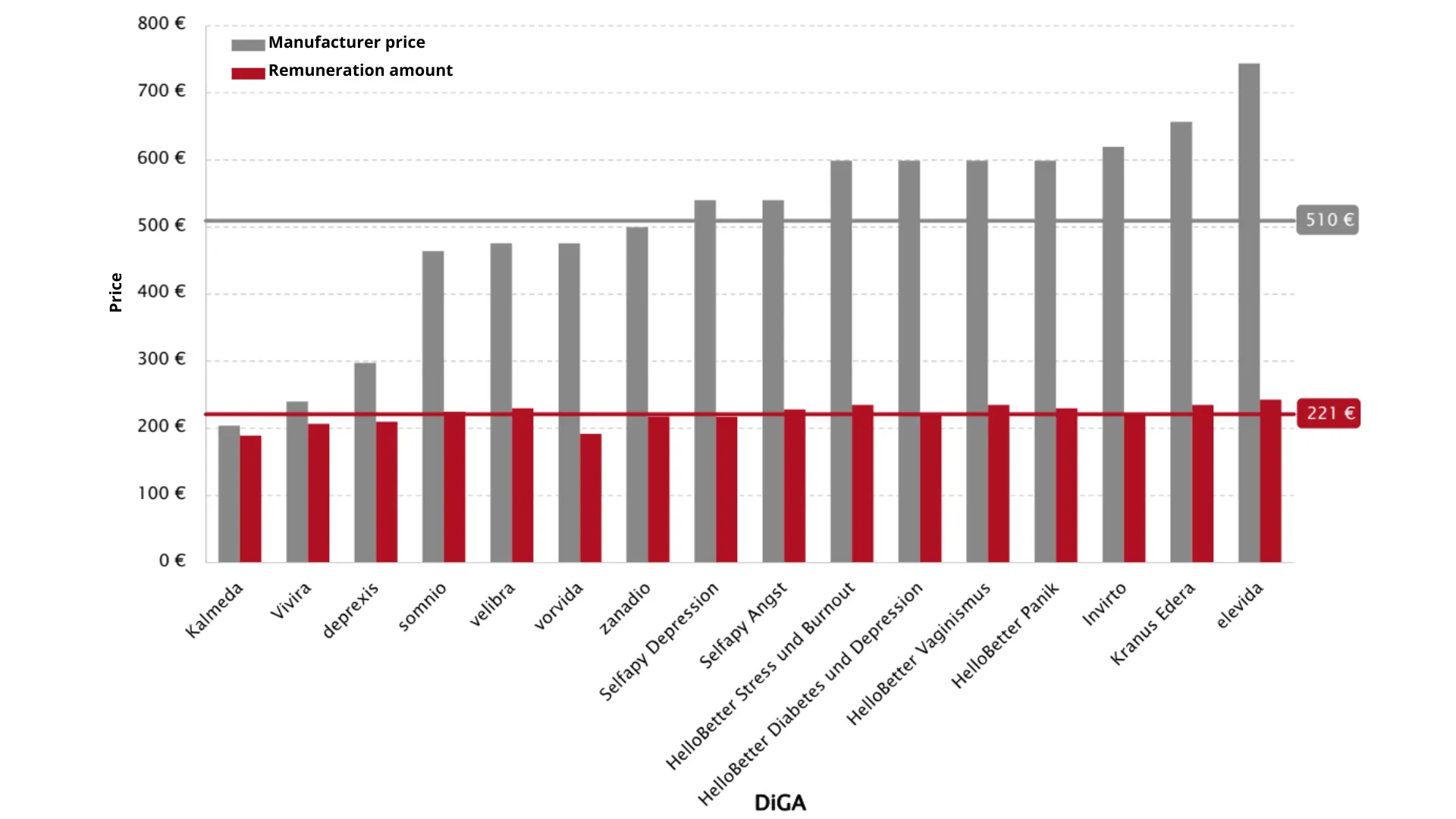
Ratio: remuneration amounts of permanently listed DiGA vs. original manufacturer prices
Source: Data from the GKV-Spitzenverband acc. § Section 33a para. 6 SGB V; as of 09/30/2023
QuickBird Medical – Recommendation
We recommend calculating conservatively so that you don’t have a nasty surprise later on if the best-case scenario in your calculation doesn’t materialize. Calculate your case at 200 euros to see whether your project would be worthwhile even at this price.
1.3 Number of activation code redemptions
In order to be able to estimate the future number of prescriptions or users of a DiGA, it is worth taking a closer look at the prevalence (proportion of people with the disease in the total population) of a particular indication. When we talk about “prevalence” in this article, we always refer to the “12-month prevalence”.
The prevalence can be obtained from epidemiological databases or health reports such as the Robert Koch Institute or statistics from the Federal Ministry of Health. A Google search is a good starting point for this.
Once you have determined the prevalence (rate), multiply it by the number of people with statutory health insurance in Germany. If you multiply this by the predicted price (see above), you get a rough estimate of the market potential of your DiGA.
Maximum unlock code redemptions = prevalence rate x number of people with statutory health insurance
Simplified example of the overall obesity DiGA market
(excluding follow-up regulations)
In 2022, the prevalence of obesity in Germany was 19%. With around 74 million people currently insured, the result is as follows:
Maximum unlock code redemptions = 0.19 x 74,000,000 = 14,060,000
(= approx. 14 million code redemptions per year)
Further down in the article, we also discuss the influence of follow-up regulations on the overall market.
1.4 Market penetration rate
So far, we have calculated the maximum sales potential of a DiGA. However, it is not realistic that you will reach every single patient in Germany with your DiGA. In the next step, you should therefore estimate the market penetration rate. This is the percentage of patients they realistically plan to reach.
To estimate the market penetration rate, you need to consider a variety of factors: do you already have access to the patient group or practitioners? If so, how many people can you reach in this way? How tech-savvy is your target group and who actually uses a smartphone? How strong is the competition from other DiGA solutions? How often are listed DiGAs currently prescribed in this area? etc.
As the market penetration rate has to be calculated very individually for each company, we cannot provide you with a generally valid guideline here.
Example based on market penetration rate
If you estimate a projected market penetration rate of 10%, you come up with a total market of 14,060,000 possible unlock code redemptions (see previous example) for obesity:
Forecasted activation code redemptions = 0.1 x 14,060,000 = 1,406,000
(approx. 1.4 million code redemptions per year)
The example illustrates what the calculation could look like in practice.
QuickBird Medical – Recommendation
Take a look at the prescribing figures for other DiGAs in the latest DiGA reports to get a feel for how often DiGAs are actually being prescribed in practice. The following figure shows an overview from the year 2023.
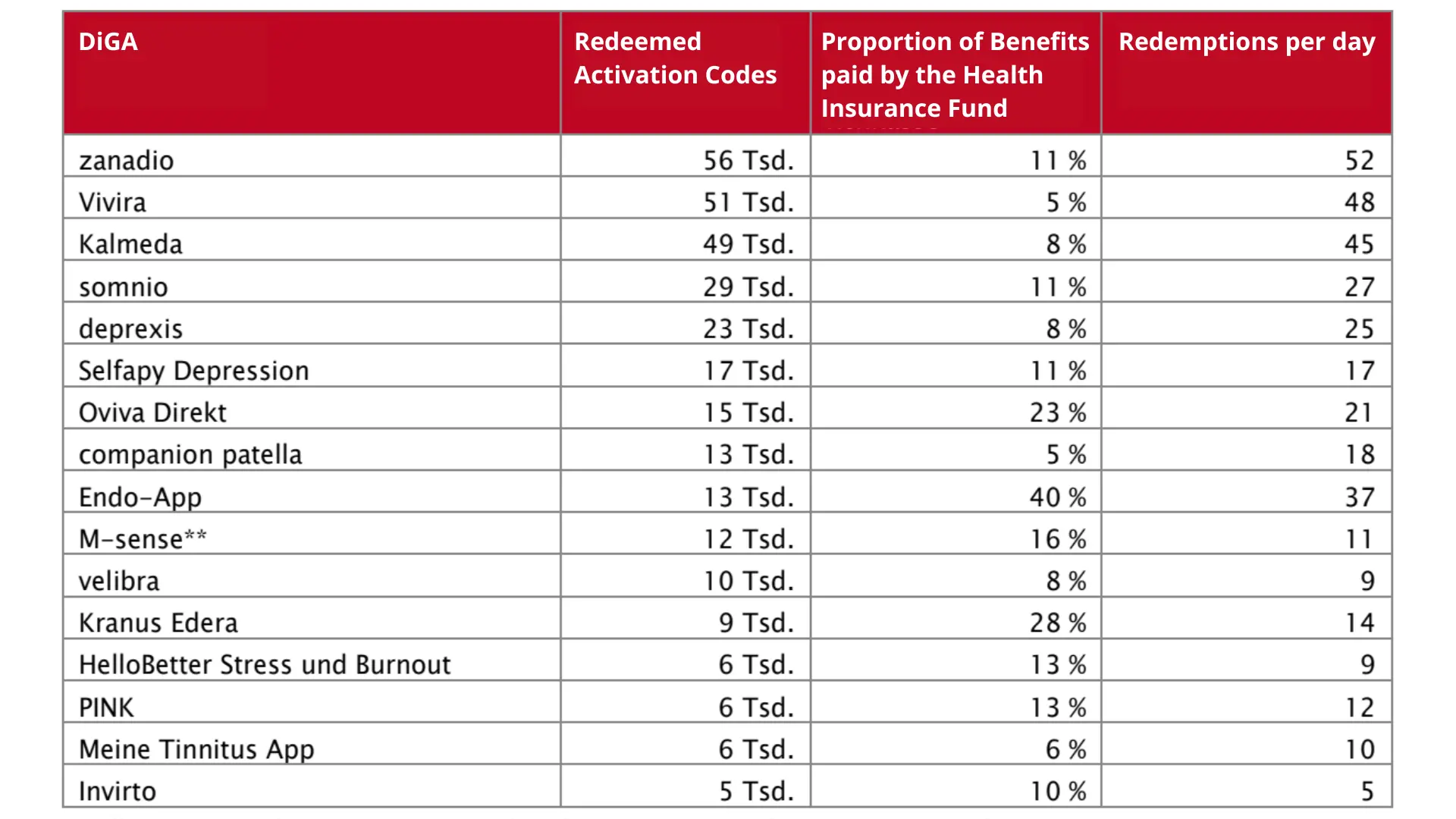
Prescriptions for DiGA with more than 5 thousand prescriptions
Source: Data from the GKV-Spitzenverband acc. § Section 33a para. 6 SGB V – as of 09/30/2023
1.5 Follow-up prescriptions of DiGA
It is also relevant to consider the difference between initial prescriptions and follow-up prescriptions in order to correctly classify its significance for the calculation.
We speak of a first prescription when the DiGA is prescribed or redeemed for the first time. A follow-up prescription may be considered if the initial prescription did not achieve the intended therapeutic goal. In this case, some DiGA can be prescribed repeatedly (if it is not a so-called one-time license).
It is particularly important to understand that 83% of all prescriptions redeemed are first-time prescriptions for a DiGA. This means that the majority of DiGA sales are generated from first prescriptions. In the case of DiGA with a single license, a follow-up prescription is even completely excluded.
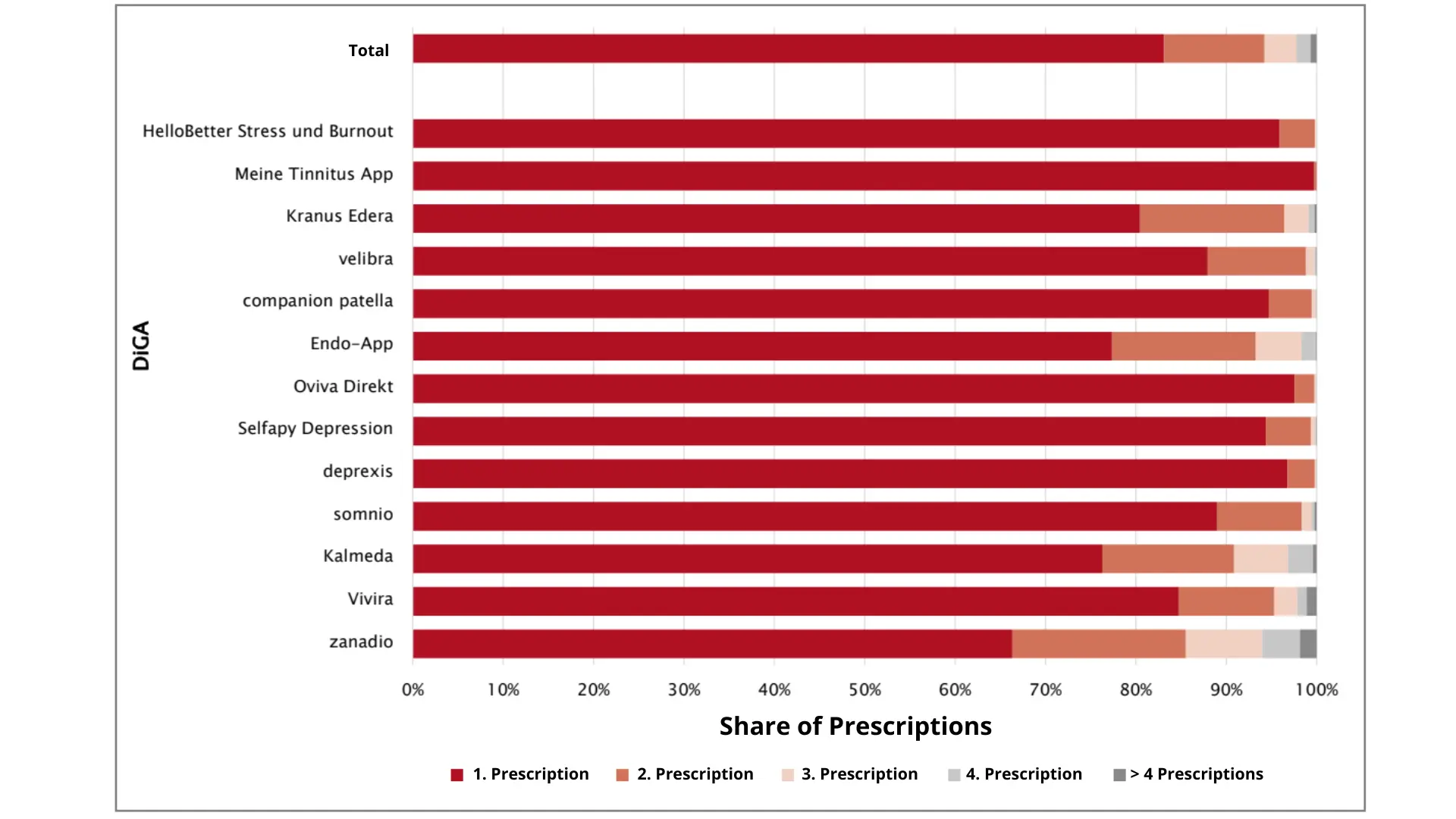
Follow-up prescriptions per DiGA
Source: Data from the GKV-Spitzenverband acc. § Section 33a para. 6 SGB V; as of 09/30/2023
When forecasting your DiGA sales, you can factor follow-up prescriptions into the projected figures based on disease prevalence.
Simplified example of the overall obesity DiGA market
(including follow-up regulations)
In 2022, the prevalence of obesity in Germany was 19%. With currently approx. 74 million insured persons and a follow-up prescription rate of 34% of the DiGA “Zanadio”, the result is:
Maximum unlock code redemptions = 0.19 * 74,000,000 * 1.34 = 18,840,400
(= approx. 19 million code redemptions per year)
1.6 Example: Forecast of DiGA sales for obesity
We have explained important aspects of sales forecasting for DiGA in the previous chapters. We will now go through the formulas with you in an example case in the obesity area.
It is important to emphasize that this example is only for the sake of clarity.. Key figures such as the market penetration rate must be calculated individually in the context of your company.
We assume the following key figures for an obesity DiGA in Germany:
Number of people with statutory health insurance: 74 million
Prevalence of obesity: 19%
Predicted follow-up prescription rate for obesity: 34 %
Projected DiGA compensation amount: € 200
Exemplary estimated market penetration rate: 10 %
This results in the following key figures for the company:
Market potential or TAM (Total Addressable Market)
= 74 million x 0.19 x 1.34 x € 200 = € 3,768,080,000
(3.7 billion euros)
Realistically addressable market or Serviceable Obtainable Market (SOM)
= 74 million x 0.19 x 1.34 x 200 € x 0.1 = 376,808,000 €
(376 million euros)
This is a simplified calculation for the entire obesity DiGA market. As a DiGA company, you will usually focus on specific ICD codes in the target market and the bill may be lower for the sub-selection of indications.
Example calculation for turnover (Zanadio)
If you look at Zanadio as a practical example in the obesity sector, sales are of course still well below the addressable market calculated as an example at the present time:
Redeemed activation codes in the period for Zanadio: 56,000
(56 thousand – data from the National Association of Statutory Health Insurance Funds in accordance with Section 33a (6) SGB V; as at 09/30/2023)
Remuneration amount for Zanadio: € 218.00
These values are used to arrive at this estimated total turnover:
Turnover = 56,000 x 218 € = 12,208,000 €
(approx. 12 million euros)
As Zanadio was initially included in the DiGA directory on a trial basis, real sales will be somewhat higher. A manufacturer’s price of € 499.80 was requested before the final remuneration amount was negotiated. The calculation here is for illustrative purposes only.
2. Costs for the development and marketing of a DiGA
Now that we have calculated the maximum yield that a DiGA can generate, the next step is of course to find out how much it costs to develop a DiGA.
The development of a DiGA is a complex process. The costs can vary greatly and depend on several factors.To give you a better overview, our free planning tool for financing your DiGA lists all the points that are particularly important in the calculation.
3. Download: Excel planner for forecasting the turnover and costs of your DiGA
With our Excel planner, you can calculate the potential revenue and costs of your digital health application in just a few minutes.
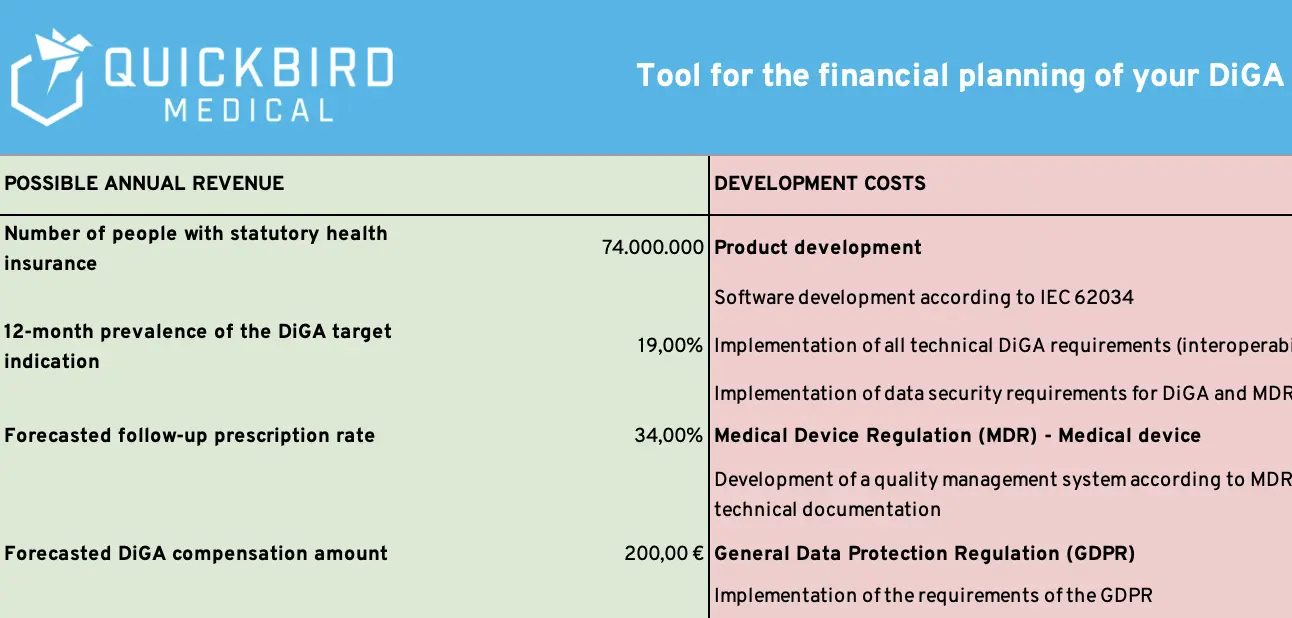
Leave your e-mail address here and we will send you the Excel planner.
4. Conclusion
Hopefully this article has helped you understand how to assess the potential of your DiGA idea.
It is of course important to understand that we have only looked at a sub-selection of important key figures for the evaluation of a DiGA business case. There are a large number of key figures that can be used to evaluate product ideas and companies. To give you an overview, we have first focused on the financial aspects, which are probably the most important at the beginning.
The fact that most companies are planning a multi-DiGA approach and are tackling further indication areas on the basis of the first DiGA is also relevant. In this case, the sales of all indication areas should be added together.
So is the development of a DiGA ultimately worthwhile? As can be easily calculated using the DiGA Excel Planner, this depends heavily on the target indication of your DiGA. For diseases with a high prevalence and, for example, a digitally-savvy target group, considerable sales can be generated in the future. In the end, of course, this also depends heavily on whether the marketing & sales of the listed DiGA is planned and executed correctly (more on this in our DiGA Marketing & Sales Guide).
Are you planning a DiGA?
Then please feel free to contact us. We specialize in the order-based implementation of DiGA and software medical products. We help you with planning, design, technical implementation and compliance with all regulatory requirements.


